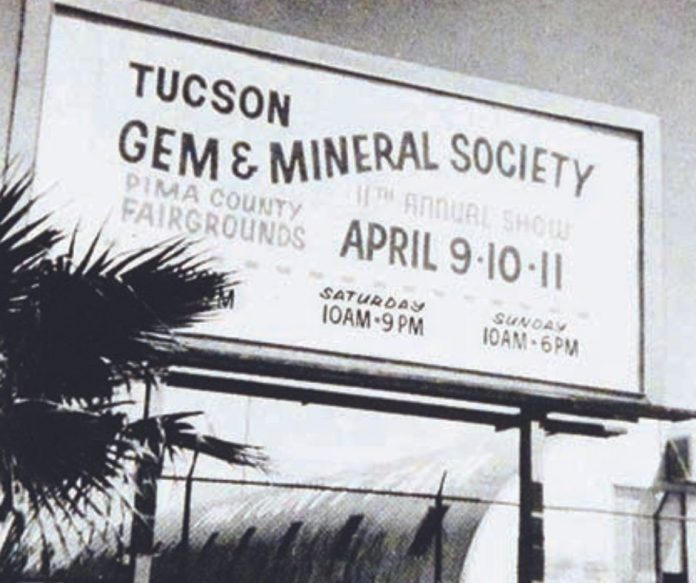
People who visit the Tucson Gem & Mineral Show may not know how the event started. Countless local mineral clubs have weekend mineral shows all over the country but only one started small and in less than ten years gained international status. The early days of the Tucson Gem and Mineral Show (TGMS) are full of history and are certainly the source of lots of odd and unusual tales.
Before the Show
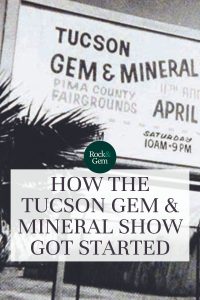
Before there was a show in Tucson the city of Phoenix, about 100 miles north, was enjoying a fine annual gem and mineral show hosted by three local clubs: Mineralogical Society of Arizona, Air Research Club and Maricopa Lapidary Society. Advising this group was Arizona’s State mineralogist and Museum Curator, Arthur Flagg.
The Phoenix Show was successful and attracted dealers and visitors from all over the west. After the Phoenix Show, many dealers would drive down to Tucson to visit the wholesale mineral dealers there to stock up. One of the dealers who attended the Phoenix Show, Bob Roots from Colorado, would go to Tucson to buy minerals after the show. He’d stay with Clayton Gibson of the Tucson Gem and Mineral Society. It was Bob in 1954, who urged Clayton to get his Tucson club to have a mineral show.
Humble Beginnings
In April 1955, the Tucson club hosted a small weekend show in the cafeteria of a local school. It was a success and the next year the show was moved to February and to a World War II Quonset hut at the county fairgrounds.
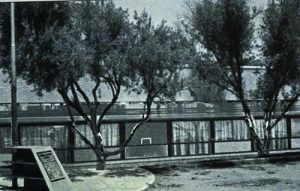
As the show grew, an area for wholesale deals was added when the TGMS expanded the show to include a second nearby building, the nearby cow barn. To use the cow barn, club volunteers showed up with brooms and shovels as there had been a cattle show the past weekend. Talk about a dusty venue! Wholesale dealers had a heck of a time just keeping their minerals clean during that show, and visitors had to deal with a very dusty atmosphere — but the wholesale event was a success!
Two rockhounds who won exhibit ribbons at this first show were Richard Bideaux and Gene Schlepp who became future leaders in the show.
The growing demand by dealers to be in Tucson during show season led to more and more sales in motels and on street corners. One dealer even rented an abandoned gas station across from the fairgrounds to conduct sales. The Holiday Inn, where the TGMS housed visiting lecturers, like Smithsonian’s Curator Paul Desautels, also attracted dealers, and eventually organized satellite shows began to appear.
By 1960, at the suggestion of Dick Bideaux, the club invited Paul Desautels of the Smithsonian to lecture at the show. With the Smithsonian participating the show gained national status in 1961.
Moving to the City
When the Show moved from the fairgrounds to the Tucson Convention Center, the nearby Desert Inn, which is no longer standing, quickly became the evening gathering place. Filled with dealers during show season, it served as a perfect social center, as dealers introduced new finds, friendships grew, and swapping of countless stories became traditional entertainment.
Unexpected Evacuation
A certain new mineral discovery gave rise to one of the more memorable Desert Inn stories. A dealer staying at the hotel had just received a large shipment of superb wire silver in calcite specimens from Batopilas, Mexico. The silver specimens needed cleaning, and the enclosing calcite had to be removed so fine silver wires would show. The dealer, pressed for time, bought gallons of pool acid (hydrochloric acid) and dumped it in his room’s bathtub immersing the calcite and silver specimens. Well, that certainly did the trick! The calcite dissolved, the silver wires were exposed, and as a result, the Desert Inn had to be evacuated because of the noxious fumes.
Another year just before showtime, as dealers were beginning to check into the hotels, a resident who had been convicted of a crime and granted a day to clear up financial affairs checked into the Desert Inn. Fearing incarceration, the man went to his room, climbed into bed, and ended his life.
Of course, the body was removed by police and the mess was tended to and the room cleaned. But, the motel owner, to save money, did not replace the mattress, which was greatly compromised. The mattress was just flipped over, and the room was rented to an unsuspecting mineral dealer. Sometimes the truth is truly more disturbing than fiction.
Elephant Incident
When the TGMS originally took over the Tucson Convention Center for the show, they did not use all of the space, including the arena. While the wholesale sales took place in a large room in the upper level of the center, the Main Exhibit Hall on the ground level housed the show. Next to the building, was the arena, which the city continued to lease or rent out for other events. Sporting events like ice hockey and basketball were held there.
In the early years, it was common practice for events to be booked into the Convention Center immediately before the Tucson Gem and Mineral Show. But one year a serious problem arose.
That year the City of Tucson had booked a circus in the arena just before the Show. When it came time for the circus to move out on a Monday before crews began setting up for the mineral show, tragedy struck. One of the circus elephants died on the arena floor. Can you imagine having to move a deceased adult elephant in a hurry? The crews were able to remove the elephant, after much effort, just in time for the start of the Show. That situation convinced the TGMS Show Committee that it would be best to have the show occupy the arena as well.
Quick Response Relocation
In 2019, the Tucson Show added another chapter to the history of the arena. By this time, the City had given overall management of the Convention Center to a private company. The new management continued accepting bookings at the arena for basketball and hockey games and concerts, just before the Tucson Gem and Mineral Show. Due to this schedule, the hockey ice is commonly left intact on the floor for use, even during the show. In the past, the ice was covered with a wooden deck, so the arena could be used for the Show.
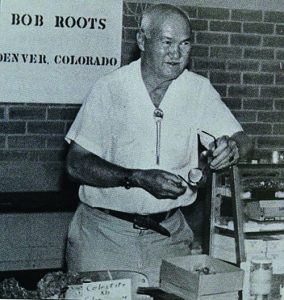
Such was the case during the February 2019 show. The arena floor was solid ice. Naturally, the Tucson Show Committee assumed the ice would be dealt with as usual. But the company managing the convention facility said the ice would remain and would be covered by temporary plywood covering, which required all tables and equipment to be carried in manually. This meant no motorized equipment could be used. How could a mineral show with heavy tables, metal curtain posts, and dealer suppliers be set up on such a weak floor? It was an impossible situation.
This left the TGMS Show Committee with a huge problem. The arena show had to be relocated. So, the Show Committee moved the dealers scheduled to be in the arena into another Convention Center area, the Grand Ballroom, which is off the main Galleria entrance. The American Gem Trade Association Show had ended a day or two before the Tucson Show, and with many sighs of relief, it worked out beautifully.
Last-Minute Ruling Keeps Show on Schedule
Another of the Tales from the Tucson Show archive saw the near cancellation or delay of the show, due to a pending court case. We did not find out until 9 a.m. on the opening day of the show if the court would rule in our favor! Fortunately, the show did open on time, and crowds of collectors entered the convention center to view the superb dealer exhibits.
The cause of this near delay/cancellation happened a year earlier, with a dispute over a dealer contract. Show contracts do not guarantee a dealer any future show space, only for the year of issue. One show dealer was not issued a contract the following year, so he sued to be allowed in. The matter went to court, and on opening day, with all of us standing around waiting, we finally got the phone call that the show could open on time!
Even before the Tucson Show opens each year the local motels are full of dealers. Motel reservations have to be made well in advance, which can be a bit of a challenge for visitors from other countries. As it happened, the curator of the Sorbonne, Paris asked a club member to make him a timely hotel reservation. The club member, fully intending to do it, forgot! When the French guest arrived, the only room available was at a motel named the “No Tell Motel?” Enough said!
The Next Step
At the behest of Dick Bideaux, the show committee invited Dr. Peter Embrey, Curator of the Gem and Mineral Collection at the Museum of Natural History in London to exhibit and lecture. Peter came in 1972 bringing with him a superb display of English minerals.
Full-Time Needs
By now, the show needed an office and a full-time show manager. The Club bought a combination meeting hall and office building. After using several part-time show managers, the club brought in Pat McClain as the full-time office manager. It is remarkable the world’s best-known gem and mineral show functions so well with a small staff and Pat’s firm hand aided by many volunteers.
Politics & Gem Shows
Another factor that played a role in the growth and success of the Tucson Gem and Mineral Show is politics. The adage “it’s not what you know but who you know” applies here. The Tucson Gem and Mineral Society was made up of a group of collectors living in the Tucson area.
One of the most active and influential groups in the City of Tucson is the Mountain Oyster Club. Mountain oysters are a desert dweller’s tongue-in-cheek name for a puma’s manhood. Some family members of this group date back to original Spanish land grants and were very active in business and local politics.
One member was critical in helping me with show publicity and government contacts including the Mayor of Tucson. I was able to work with this group which was a big help as the Show gained status.
Dick Bideaux’s father owned small-town newspapers in Southern Arizona and was a big help with publicity. He was also politically active and well-connected.
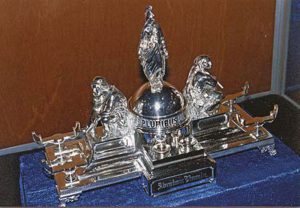
The Udall family was active in Arizona politics and through them, we were able to approach the Library of Congress to borrow the Silver desk set and ink well given to Abraham Lincoln by the Governor of Arizona for signing the treaty to bring Southern Arizona into the United States. The silver desk set was made of silver mined in Arizona.
Fabergé Eggs
Show visitors were also in a position to help grow the show. One regular exhibitor collector happened to live next door to Malcolm Forbes, once owner of many Russian Peter Carl Faberge Easter eggs made each year for the Czarina. We proposed to the Forbes Museum, New York, asking for an Easter egg display. They agreed and this also brought the Russian Ambassador to the show. As luck would have it the last living member of the Faberge family, Tatiana Faberge was visiting Phoenix at the time and she brought an exhibit of Faberge materials.
Dedicated Volunteers
The club’s members who volunteered for days, weeks and years were and still are the heart and basis on which the show grows.
This story about how the Tucson Gem and Mineral Show got started appeared in Rock & Gem magazine. Click here to subscribe. Story by Bob Jones.















